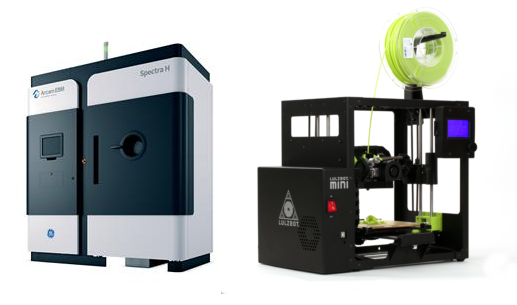EBM technology remains the only commercial one capable of 3D printing with these materials, which include titanium alumide (TiAl). The Arcam EBM Spectra H will support TiAl and Alloy 718 right away, and will add additional Ni- super alloys starting in 2019. GE Additive’s materials science team is exploring future opportunities for a wider range of high heat materials, such as nickel superalloys, tungsten, CoCr, stainless steel and metal matrix composites.
The Arcam EBM Spectra H boasts a 50% faster build speed, thanks to a 6kW HV-unit which enables all pre- and post-processing steps to take place in half the time. Theme improvements increase the build speed even further, and an improved layering procedure reduces the need for heating, saving about five hours for a full height build. The Spectra H also features improved heat management through the incorporation of a moveable heat shield that keeps heat in the build area.“It’s great to be able to show the Spectra H here at RAPID and get feedback from across the industry,” said Karl Lindblom, General Manager at Arcam EBM. “We have created what we think is an amazing system that demonstrates how Arcam continues to push the possibilities of EBM technology. Spectra H is the result of really hard work by a cross-functional team from across the GE Additive family, supported by insights and feedback from a handful of internal and external customers.”
The build volume has been increased by 39% from 200 x 200 x 380mm to Ø250 x 430mm. The Spectra H also features Arcam xQam automatic calibration technology, which improves the position and focus accuracy and removes need for manual calibration, reducing the process from three or four hours to 15 minutes. This feature will also be incorporated on all Qplus systems, and the project team is exploring the potential for future in situ part qualification.
When developing the Arcam EBM Spectra H, there was a strong focus on automation. This includes an automated, self-dosing sieve and hopper filling station process. Powder weight is controlled in the PRS and inside the hopper filling station. Automatic powder hoppers are self-closing when lifted and self-opening when mounted in the machine, which features a one powder distribution set up for each material. Calibration of the fetch position now only needs to take place during a material change, no longer before the machine starts.
The Spectra H has a closed powder handling system, so the operator is protected from the powder and the batch maintains integrity. Removal of unwanted particles is handled by a thorough process: a cyclone for small and low-density particles, and a sieve for coarse particles and magnetic traps.
On the desktop side of things, LulzBot has also introduced a new 3D printer at RAPID this week. The LulzBot Mini 2 features several hardware improvements over the original Mini. Einsy RAMBo electronics with Trinamic drivers allow for quiet operation and a build volume increase of about 20% over the previous model, with no increase in footprint. The new 3D printer features a belt-driven Z-axis which allows for rapid travel and accurate layer alignment, with no reduction in minimum resolution. Several accessories which were only offered as add-ons with the original Mini are now included as standard:“This new system shows our commitment to developing industry-leading additive machines, materials, and services,” said Jason Oliver, President and CEO of GE Additive. “We remain focused on accelerating innovation across sectors and helping the world work smarter, faster and more efficiently.”
- A next generation Aerostruder Tool Head designed around the E3D Titan Aero hot end and extruder
- The LulzBot modular bed system with reversible heated glass/PEI surface
- A Graphical LCD Controller for tetherless operation
“The original LulzBot Mini revolutionized the category by offering ease of use and workhorse reliability in a compact package,” Aleph Objects’ Director of Marketing Ben Malouf said. “With the Mini 2 we listened to our users’ feedback and added improvements like SD card printing and much quieter operation, but we kept what they love: the rugged, portable form factor; material versatility; and fantastic print quality.”
LulzBot is also now offering Cura LulzBot edition 3.2 in public beta, and the final release is anticipated in advance of Mini 2 shipment. The new version includes faster load times, an updated interface, and lots of new slicing options.
The LulzBot Mini 2 will be on display at LulzBot’s booth, #404, at RAPID this week.
Discuss these and other 3D printing topics at 3DPrintBoard.com or share your thoughts below.
